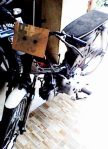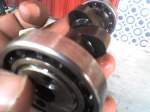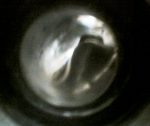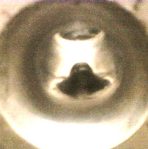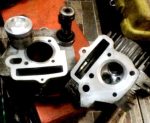WE STOOD SCRATCHING our heads, thinking that this was not going to work. How on earth were we going to stuff a mountain of boxes into this hatchback? Honda had set an exercise for us to showcase the phenomenally spacious and flexible interiors of the Jazz and to have a bit of fun as well. The amount of luggage was fit for an estate car but the Jazz’s ‘magic’ rear seats which lift, spilt and fold completely flat lived up to their name by conjuring space where
you thought there was none.
SPACE shuttle
The brilliance of the Jazz lies in its unbelievable space efficiency. It also demonstrates Honda’s engineering expertise and lateral thinking in putting to good use every millimetre of the car. The key to the brilliant packaging is the cab-forward design and centrally-mounted fuel tank which liberates space under the rear seats (where most fuel tanks usually sit). So even though this car’s wheelbase, at 2500mm, is shorter than other big hatchbacks like the Hyundai i20, the car has acres more space.
Entry into the massive cabin is made easy by large doors which open wide. Outside visibility is superb, thanks to the generous glass area (especially the large, front quarter-windows) and slim A-pillars. The front seats have a tall seating position and are pretty broad with generous bolstering but there’s no height adjust which compromises ultimate comfort.
In the rear, the seat squab is a touch short, so under-thigh support is not as good as we would have liked. Other than that, it’s hard to fault the back seat. The high ‘H-point’ adjustable back rest, terrific head- and legroom plus generous width make the Jazz’s bench the comfiest we have seen in any hatchback by far. The rear seat is wide enough for three persons and the absence of an armrest makes life better for the middle passenger. The flexible manner in which the rear seats function is also outstanding. Well-engineered latches and levers allow you to flip up or collapse the seats neatly into the floor, with just one hand.
The tricks don’t end with the seats. You can spend the whole day discovering ingenious storage areas Honda has carved out of the Jazz. There are two medium-sized gloveboxes with a shelf in between, some storage space under the central console and between the seats, a secret box under the rear seats as well and 10 cupholders. Yes, ten! One in each door — four, one each at each end of the dashboard in front of the air-con vents (to keep your drinks cool), two ahead of the gear lever, and a pair between the front seats. Honda hasn’t spared the boot area either. There’s a small shelf tucked into the side. The boot area is massive too – 366 litres which can take a couple of large suitcases without the need to fold the seats. The large boot has made conspicuous the absence of a rear parcel shelf — a shocking omission for such a pricey hatch. Come on Honda, even the Maruti A-star has one!
Thankfully, such blatant cost-cutting isn’t carried over to the passenger area. While the Jazz shares a lot of its mechanical components with the City, there is very little on the inside to suggest this. The steering wheels, dials and gear knob are the only bits that are shared but otherwise the Jazz’s cabin has a completely different vibe to it. In fact, interior quality feels a notch above the more expensive City. The Jazz’s plastics and fabrics have a richer feel and even the doors shut with a more solid thud than the City’s.
The dashboard design and functionality is very different from the norm. The chunky air-con knobs have a solid feel and function superbly, except for the low-rent fresh air/re-circ slider. Honda has packaged all the essentials into the top of the central console, freeing up storage space below. The Jazz gets a CD player unlike the City’s music system which runs off a memory stick or iPod. Steering audio controls, real-time fuel consumption, airbags and ABS are also standard. There are no alloys but the dull silver wheel caps on steel wheels look quite good.
JAZZ HAS PIZZAZZ
There was a time when all Hondas looked boring. Designed to be inoffensive to the majority of the world’s population, a Honda’s safe lines and bland details made it dull to look at. Today, however, things are very different. The Civic and City have path-breaking designs and the Jazz, despite its MPV-like proportions, looks terrific too.
The edgy styling gives the Jazz a futuristic look that modern Hondas are known for. The stubby, pointed nose with large triangular headlights is particularly stunning. The power bulge on the bonnet catches the light perfectly and the car has been given a strong chin too, which goes well with its tipped-forward stance. Honda designers have used a bulging rear wheel arch with strong cut lines to break up the mass of the side of the car and at the rear a wide, flush-mounted windscreen makes the car look unique too.
SMALL BUT POTENT
The Jazz comes with a wide range of engines for international markets but for India there is only one engine option — a 1198cc petrol motor developing an impressive 89bhp. Cars with engines below 1.2 litres get huge savings in excise duty and this is the main reason why the Jazz and most other hatchbacks come with engines under this limit.
However, all 1.2-litre engines are not the same, especially if it’s a Honda. While Maruti and Hyundai offer double overhead camshafts on their 1.2 engines for greater performance and control, Honda fights back with a single camshaft but with a new version of its patented variable valve timing system (i-VTEC). One of the jobs of the i-VTEC system is to improve the flexibility and efficiency of the engine. Slender rocker arms play the 16 valves like an expert trumpeter, deactivating one intake valve below 2100rpm. This not only improves efficiency but improves low-end response, the theory being that the narrower passage (with only one valve closed) speeds up airflow.
The theory works. The Jazz responds smartly to a dab on the accelerator and feels quite perky at low speeds. Ambling in traffic is quite easy and part-throttle response is pretty good. However, Honda motors work best at high revs, where they almost seem more at home and the Jazz’s motor is no different. It gets a second wind past 5000rpm and races to its 6500rpm redline. Flat-out acceleration is pretty strong, considering the size of the motor. Zero to 100kph comes up in 13.2seconds with 120 taking a total of 18.6sec. This easily makes the Jazz the fastest of the 1.2 petrol brigade. This engineis also very refined. Idle is almost inaudible, the motor purrs at low engine speeds and it’s only when you are really pushing it to the maximum that it gets slightly louder.
If there is a flaw in this engine it’s the weak midrange. Peak torque is a decent 11.2kgm but it is developed at a high 4800rpm. It feels quite gutless below 4000rpm and you have to constantly downshift to avoid getting bogged down. Drivability is further hampered by the significant gap between second and third gear ratios. It’s just as well that the slick-shifting gearbox is an absolute delight to use.
JAZZ BALLET
On its raised suspension and weedy tyres, the Jazz doesn’t quite handle like a hot hatch and this is not a car you look forward to getting behind the wheel of on a twisting road. The stiff chassis and taut suspension give decent body control but the limitation is the low-rolling resistance Michelins, which give up grip quite easily. The steering feel is similar to the current City’s — not completely disconnected as before but still a touch too light to instill confidence at high speeds. Ride quality isn’t brilliant either.
The jacked-up and stiffened suspension copes well with smooth surfaces but it crashes over sharp ridges and potholes, which makes it pretty jarring for passengers. Also, the tyres drum up a fair amount of road noise on patchy surfaces and this is accentuated by the silent powertrain.
Dynamically, the Jazz is a far cry from the Fabia or Grande Punto which feel much more planted and secure at highway speeds and over rough surfaces. Pushing the Jazz to its limit isn’t always fun and you are much happier turning the pace a notch down. The Jazz is not a great highway car and it feels most comfortable at moderate speeds in urban surroundings where the light steering and nimble handling become strengths.
FIRST VERDICT
Available with only one engine option but in three variants, the Jazz’s pricing is stratospheric by hatchback standards. The base model nudges Rs 8.28 lakh (on-road, Mumbai) while the top-of-the-line Active model, which gets an assortment of sporty body mods and add-ons costs Rs 8.66 lakh. There is a decent level of equipment but not enough to justify the over-the-top price. To put it in perspective, a fully-loaded Skoda Fabia 1.2 costs Rs 1.6 lakh less. The Jazz’s price is closer to the City’s, which is also expensive by saloon-car standards.
But the Jazz offers more in some areas than its saloon sibling. The build quality is better, especially on the inside, and the rear seat is more comfy too. Plus, it offers practicality no saloon car can hope to match. Look at all the flexible luggage space and you know why Honda chose to call this car the Jazz — it can swallow a whole jazz band, trumpet, trombone, saxophone, drum kit and possibly the double bass too.
No doubt, the Jazz is a brilliantly designed and engineered car. The 1.2 engine is adequate for city use and promises to be efficient. Like most Hondas, the Jazz should be super-reliable. As an overall package, it does the job better than any other hatchback in the market. It offers everything except value for money, especially for a hatch.
However, what you get is something unique, a classy, well-thought-out and engineered car built to global standards. You get that precise Honda fit and quality, the brilliant packaging, plenty of clever bits and the promise of great fuel economy and reliability. If you are looking for an entry saloon or pure driving pleasure, the Jazz is not the car for you. It’s a smarter, more stylish and better packaged alternative to a saloon but nonetheless an expensive one.
you thought there was none.
SPACE shuttle
The brilliance of the Jazz lies in its unbelievable space efficiency. It also demonstrates Honda’s engineering expertise and lateral thinking in putting to good use every millimetre of the car. The key to the brilliant packaging is the cab-forward design and centrally-mounted fuel tank which liberates space under the rear seats (where most fuel tanks usually sit). So even though this car’s wheelbase, at 2500mm, is shorter than other big hatchbacks like the Hyundai i20, the car has acres more space.
Entry into the massive cabin is made easy by large doors which open wide. Outside visibility is superb, thanks to the generous glass area (especially the large, front quarter-windows) and slim A-pillars. The front seats have a tall seating position and are pretty broad with generous bolstering but there’s no height adjust which compromises ultimate comfort.
In the rear, the seat squab is a touch short, so under-thigh support is not as good as we would have liked. Other than that, it’s hard to fault the back seat. The high ‘H-point’ adjustable back rest, terrific head- and legroom plus generous width make the Jazz’s bench the comfiest we have seen in any hatchback by far. The rear seat is wide enough for three persons and the absence of an armrest makes life better for the middle passenger. The flexible manner in which the rear seats function is also outstanding. Well-engineered latches and levers allow you to flip up or collapse the seats neatly into the floor, with just one hand.
The tricks don’t end with the seats. You can spend the whole day discovering ingenious storage areas Honda has carved out of the Jazz. There are two medium-sized gloveboxes with a shelf in between, some storage space under the central console and between the seats, a secret box under the rear seats as well and 10 cupholders. Yes, ten! One in each door — four, one each at each end of the dashboard in front of the air-con vents (to keep your drinks cool), two ahead of the gear lever, and a pair between the front seats. Honda hasn’t spared the boot area either. There’s a small shelf tucked into the side. The boot area is massive too – 366 litres which can take a couple of large suitcases without the need to fold the seats. The large boot has made conspicuous the absence of a rear parcel shelf — a shocking omission for such a pricey hatch. Come on Honda, even the Maruti A-star has one!
Thankfully, such blatant cost-cutting isn’t carried over to the passenger area. While the Jazz shares a lot of its mechanical components with the City, there is very little on the inside to suggest this. The steering wheels, dials and gear knob are the only bits that are shared but otherwise the Jazz’s cabin has a completely different vibe to it. In fact, interior quality feels a notch above the more expensive City. The Jazz’s plastics and fabrics have a richer feel and even the doors shut with a more solid thud than the City’s.
The dashboard design and functionality is very different from the norm. The chunky air-con knobs have a solid feel and function superbly, except for the low-rent fresh air/re-circ slider. Honda has packaged all the essentials into the top of the central console, freeing up storage space below. The Jazz gets a CD player unlike the City’s music system which runs off a memory stick or iPod. Steering audio controls, real-time fuel consumption, airbags and ABS are also standard. There are no alloys but the dull silver wheel caps on steel wheels look quite good.
JAZZ HAS PIZZAZZ
There was a time when all Hondas looked boring. Designed to be inoffensive to the majority of the world’s population, a Honda’s safe lines and bland details made it dull to look at. Today, however, things are very different. The Civic and City have path-breaking designs and the Jazz, despite its MPV-like proportions, looks terrific too.
The edgy styling gives the Jazz a futuristic look that modern Hondas are known for. The stubby, pointed nose with large triangular headlights is particularly stunning. The power bulge on the bonnet catches the light perfectly and the car has been given a strong chin too, which goes well with its tipped-forward stance. Honda designers have used a bulging rear wheel arch with strong cut lines to break up the mass of the side of the car and at the rear a wide, flush-mounted windscreen makes the car look unique too.
SMALL BUT POTENT
The Jazz comes with a wide range of engines for international markets but for India there is only one engine option — a 1198cc petrol motor developing an impressive 89bhp. Cars with engines below 1.2 litres get huge savings in excise duty and this is the main reason why the Jazz and most other hatchbacks come with engines under this limit.
However, all 1.2-litre engines are not the same, especially if it’s a Honda. While Maruti and Hyundai offer double overhead camshafts on their 1.2 engines for greater performance and control, Honda fights back with a single camshaft but with a new version of its patented variable valve timing system (i-VTEC). One of the jobs of the i-VTEC system is to improve the flexibility and efficiency of the engine. Slender rocker arms play the 16 valves like an expert trumpeter, deactivating one intake valve below 2100rpm. This not only improves efficiency but improves low-end response, the theory being that the narrower passage (with only one valve closed) speeds up airflow.
The theory works. The Jazz responds smartly to a dab on the accelerator and feels quite perky at low speeds. Ambling in traffic is quite easy and part-throttle response is pretty good. However, Honda motors work best at high revs, where they almost seem more at home and the Jazz’s motor is no different. It gets a second wind past 5000rpm and races to its 6500rpm redline. Flat-out acceleration is pretty strong, considering the size of the motor. Zero to 100kph comes up in 13.2seconds with 120 taking a total of 18.6sec. This easily makes the Jazz the fastest of the 1.2 petrol brigade. This engineis also very refined. Idle is almost inaudible, the motor purrs at low engine speeds and it’s only when you are really pushing it to the maximum that it gets slightly louder.
If there is a flaw in this engine it’s the weak midrange. Peak torque is a decent 11.2kgm but it is developed at a high 4800rpm. It feels quite gutless below 4000rpm and you have to constantly downshift to avoid getting bogged down. Drivability is further hampered by the significant gap between second and third gear ratios. It’s just as well that the slick-shifting gearbox is an absolute delight to use.
JAZZ BALLET
On its raised suspension and weedy tyres, the Jazz doesn’t quite handle like a hot hatch and this is not a car you look forward to getting behind the wheel of on a twisting road. The stiff chassis and taut suspension give decent body control but the limitation is the low-rolling resistance Michelins, which give up grip quite easily. The steering feel is similar to the current City’s — not completely disconnected as before but still a touch too light to instill confidence at high speeds. Ride quality isn’t brilliant either.
The jacked-up and stiffened suspension copes well with smooth surfaces but it crashes over sharp ridges and potholes, which makes it pretty jarring for passengers. Also, the tyres drum up a fair amount of road noise on patchy surfaces and this is accentuated by the silent powertrain.
Dynamically, the Jazz is a far cry from the Fabia or Grande Punto which feel much more planted and secure at highway speeds and over rough surfaces. Pushing the Jazz to its limit isn’t always fun and you are much happier turning the pace a notch down. The Jazz is not a great highway car and it feels most comfortable at moderate speeds in urban surroundings where the light steering and nimble handling become strengths.
FIRST VERDICT
Available with only one engine option but in three variants, the Jazz’s pricing is stratospheric by hatchback standards. The base model nudges Rs 8.28 lakh (on-road, Mumbai) while the top-of-the-line Active model, which gets an assortment of sporty body mods and add-ons costs Rs 8.66 lakh. There is a decent level of equipment but not enough to justify the over-the-top price. To put it in perspective, a fully-loaded Skoda Fabia 1.2 costs Rs 1.6 lakh less. The Jazz’s price is closer to the City’s, which is also expensive by saloon-car standards.
But the Jazz offers more in some areas than its saloon sibling. The build quality is better, especially on the inside, and the rear seat is more comfy too. Plus, it offers practicality no saloon car can hope to match. Look at all the flexible luggage space and you know why Honda chose to call this car the Jazz — it can swallow a whole jazz band, trumpet, trombone, saxophone, drum kit and possibly the double bass too.
No doubt, the Jazz is a brilliantly designed and engineered car. The 1.2 engine is adequate for city use and promises to be efficient. Like most Hondas, the Jazz should be super-reliable. As an overall package, it does the job better than any other hatchback in the market. It offers everything except value for money, especially for a hatch.
However, what you get is something unique, a classy, well-thought-out and engineered car built to global standards. You get that precise Honda fit and quality, the brilliant packaging, plenty of clever bits and the promise of great fuel economy and reliability. If you are looking for an entry saloon or pure driving pleasure, the Jazz is not the car for you. It’s a smarter, more stylish and better packaged alternative to a saloon but nonetheless an expensive one.

- Flexible, spacious cabin
- Peppy performance
- Equipment

- Expensive
- Engine lacks torque

HONDA JAZZ | |
| Price | 8.26 lakh (On-road price Mumbai) |
| Length | 3900 mm |
| Width | 3900mm |
| Height | 1695mm |
| Wheelbase | 1535mm |
| Ground clearance | 160 mm |
ENGINE | |
| Installation | Front, transverse |
| Type | Layout4-cyls in-line, 1198cc |
| Bore/stroke | 73/71.58mm |
| Power | 89bhp at 6200rpm |
| Torque | 11.2 kgm at 4800 rpm |
| Gearbox | 5-speed manual |
| Brakes(f/r) | Ventilated discs/drums |
| Tyre size | 175/65 R-15 |












